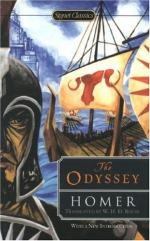{117} The rock at the end of the Northern harbour of Trapani, to which I suppose the writer of the “Odyssey” to be here referring, still bears the name Malconsiglio—“the rock of evil counsel.” There is a legend that it was a ship of Turkish pirates who were intending to attack Trapani, but the “Madonna di Trapani” crushed them under this rock just as they were coming into port. My friend Cavaliere Giannitrapani of Trapani told me that his father used to tell him when he was a boy that if he would drop exactly three drops of oil on to the water near the rock, he would see the ship still at the bottom. The legend is evidently a Christianised version of the Odyssean story, while the name supplies the additional detail that the disaster happened in consequence of an evil counsel.
{118} It would seem then that the ship had got all the way back from Ithaca in about a quarter of an hour.
{119} And may we not add “and also to prevent his recognising that he was only in the place where he had met Nausicaa two days earlier.”
{120} All this is to excuse the entire absence of Minerva from books ix.-xii., which I suppose had been written already, before the authoress had determined on making Minerva so prominent a character.
{121} We have met with this somewhat lame attempt to cover the writer’s change of scheme at the end of bk. vi.
{122} I take the following from The Authoress of the Odyssey, p. 167. “It is clear from the text that there were two [caves] not one, but some one has enclosed in brackets the two lines in which the second cave is mentioned, I presume because he found himself puzzled by having a second cave sprung upon him when up to this point he had only been told of one.
“I venture to think that if he had known the ground he would not have been puzzled, for there are two caves, distant about 80 or 100 yards from one another.” The cave in which Ulysses hid his treasure is, as I have already said, identifiable with singular completeness. The other cave presents no special features, neither in the poem nor in nature.
{123} There is no attempt to disguise the fact that Penelope had long given encouragement to the suitors. The only defence set up is that she did not really mean to encourage them. Would it not have been wiser to have tried a little discouragement?
{124} See map near the end of bk. vi. Ruccazzu dei corvi of course means “the rock of the ravens.” Both name and ravens still exist.
{125} See The Authoress of the Odyssey, pp. 140, 141. The real reason for sending Telemachus to Pylos and Lacedaemon was that the authoress might get Helen of Troy into her poem. He was sent at the only point in the story at which he could be sent, so he must have gone then or not at all.
{126} The site I assign to Eumaeus’s hut, close to the Ruccazzu dei Corvi, is about 2,000 feet above the sea, and commands an extensive view.




